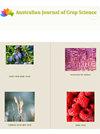Evaluating the adaptability and stability of common peanut varieties (Arachis hypogaea L.) in Northern Mozambique using the AMMI Bayesian model
Q3 Agricultural and Biological Sciences
引用次数: 0
Abstract
This study evaluated the stability and adaptability of common peanut cultivars (Arachis hypogaea L.) in three locations across northern Mozambique over four years, using the additive main effects and multiplicative interaction model (AMMI) under a Bayesian approach. The multi-environmental data consisted of 20 genotypes evaluated in three locations. We analyzed grain yield in tons per hectare in a complete randomized block design for each location. The results indicated that genotypes with higher marginal yield contribute to the genotype by environment interaction (GEI) and thus are not largely recommended for the entire target environment. The Namapa (NMP) location showed consistent behavior and did not contribute to the GEI effect, and in this sense, G6 and G7 would be the best indications for this location. Moreover, genotypes considered stable, with emphasis on the G20 genotype, did not have a good average yield. Mapupulo (MPPL) and Nampula (NLP) had a significant contribution to GEI, and the best genotypes for these locations were G7 and G3, respectively. In this sense, the results of the analysis specified that using genotypes in specific environments would be the best strategy to decrease the effect of GEI and increase peanut productivity in the environments considered利用AMMI贝叶斯模型评价莫桑比克北部常见花生品种(Arachis hypogaea L.)的适应性和稳定性
本研究利用贝叶斯方法下的可加性主效应和乘法互作模型(AMMI),对莫桑比克北部3个地区4年时间内常见花生品种(arachhis hypogaea L.)的稳定性和适应性进行了评价。多环境数据包括在三个地点评估的20个基因型。我们在每个地点的完全随机区组设计中以每公顷吨为单位分析了粮食产量。结果表明,边际产量较高的基因型通过环境相互作用(GEI)对基因型做出贡献,因此不推荐用于整个目标环境。Namapa (NMP)位置表现出一致的行为,对GEI效应没有贡献,因此G6和G7是该位置的最佳指示。此外,被认为稳定的基因型,特别是G20基因型,平均产量并不高。Mapupulo (MPPL)和Nampula (NLP)对GEI的贡献显著,其最佳基因型分别为G7和G3。从这个意义上说,分析结果表明,在特定环境中使用基因型将是在所考虑的环境中降低GEI影响并提高花生产量的最佳策略
本文章由计算机程序翻译,如有差异,请以英文原文为准。
求助全文
约1分钟内获得全文
求助全文
来源期刊

Australian Journal of Crop Science
农林科学-农艺学
CiteScore
1.20
自引率
0.00%
发文量
75
审稿时长
3.5 months
期刊介绍:
Information not localized
 求助内容:
求助内容: 应助结果提醒方式:
应助结果提醒方式:


